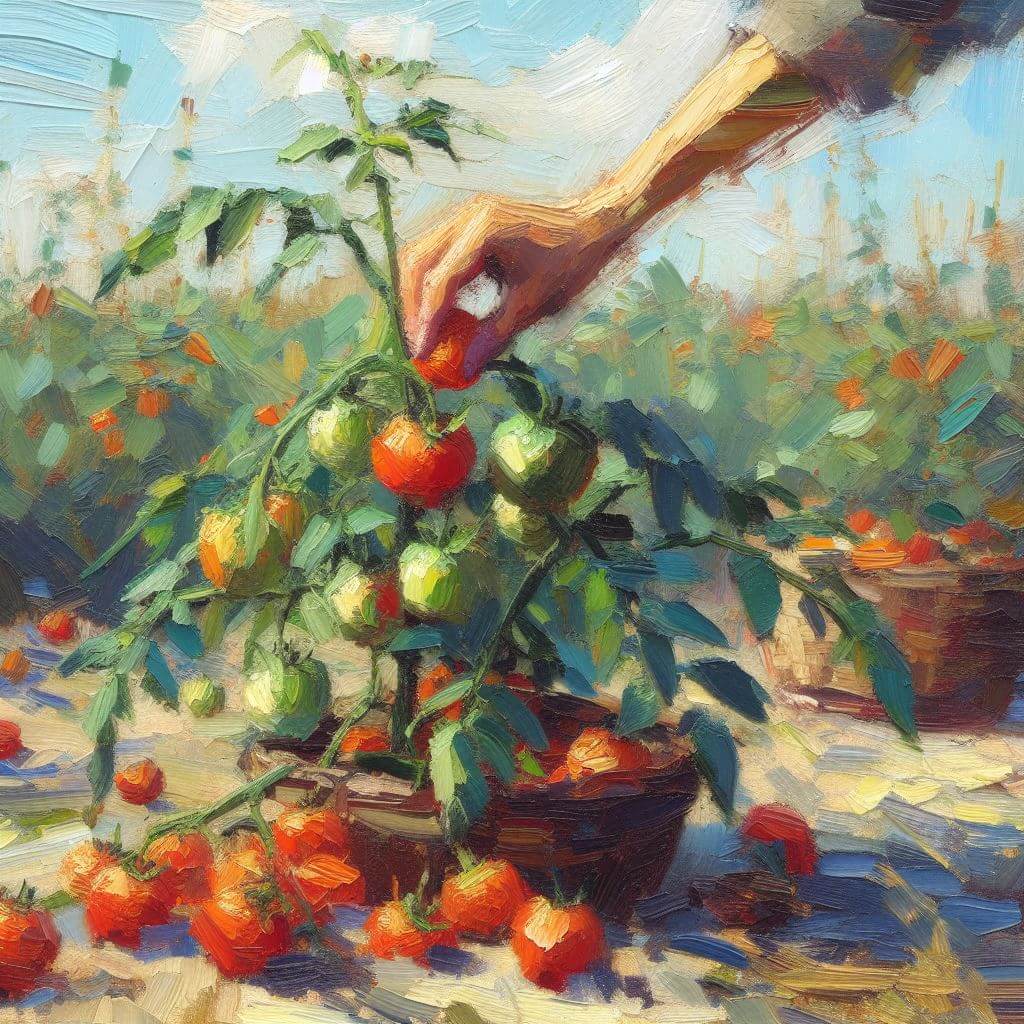
Growing your own food can be a rewarding experience, particularly when you’re cultivating something as versatile and delicious as tomatoes. Not only do homegrown tomatoes taste better than those you buy at the store, but you also have the satisfaction of knowing exactly where your food is coming from.
Understanding Tomatoes
Tomatoes are one of the most popular plants to grow at home, and it’s easy to see why. They’re versatile, delicious, and relatively low-maintenance. Tomatoes are rich in vitamins A, C, and K, and they’re also a good source of potassium and fiber. They’re used in a variety of dishes, from salads to sauces, making them a staple in many households.
The Uniqueness of Utah: A Perfect Place for Tomatoes
Utah’s climate, with its hot summers and cool, but not freezing, winters, is ideally suited for growing tomatoes. The state’s rich, well-draining soil is another advantage. Tomatoes thrive in conditions that allow their roots to spread out and access the nutrients they need, and Utah’s soil provides just that.
Additionally, Utah’s relatively low humidity levels can help prevent some of the fungal diseases that tomatoes are prone to, making it easier for you to maintain a healthy crop.

Best Time to Plant Tomatoes in Utah
Knowing when to plant tomatoes can make all the difference in how well your plants grow and how much they produce. In general, the best time to plant tomatoes in Utah is in late spring, after the last frost has passed. This usually occurs between mid-May and early June.
Planting at this time allows the tomato plants to take advantage of Utah’s long, hot summers. The heat helps the plants grow quickly, while the cooler autumn months give the tomatoes a chance to ripen to perfection.
However, the exact timing can vary depending on the specific region within Utah and the weather patterns in a given year. For example, if the spring is particularly cold or the winter frost lingers, you may need to delay planting until the conditions improve.
When to Plant Tomatoes in Utah: Region-Specific Recommendations
Northern Utah
This region includes areas such as Logan and Brigham City. It’s typically cooler here than in other regions of Utah, and the growing season is shorter. The best time to plant tomatoes in Northern Utah is usually in late May once the soil has warmed up sufficiently.
Central Utah
Home to areas like Provo and Orem, Central Utah has a somewhat milder climate. You can typically plant tomatoes here in mid-May, after the last frost has passed and the ground has had a chance to warm up.
Southern Utah
Southern Utah, encompassing areas like St. George and Cedar City, sees hotter summers and milder winters. The growing season here is longer, and you can usually start planting tomatoes in early to mid-April, after the danger of frost has passed.
Eastern Utah
Areas like Moab and Price fall under this region. Eastern Utah has a semi-arid climate, with hot summers and cold winters. Here, the ideal time to plant tomatoes is generally around mid-May, once the soil has warmed and the risk of frost has subsided.
Western Utah
The Western region of Utah includes areas like the West Desert and the Bonneville Salt Flats. This region sees a continental climate with cold winters and hot, dry summers. It’s best to plant tomatoes in late May to early June here, as the soil takes a bit longer to warm up due to the region’s unique geographical features.

Planting Tomatoes: A Step-by-Step Guide
Growing tomatoes isn’t just about knowing when to plant them. It’s also about knowing how to plant them. Here’s a step-by-step guide to get you started:
Choose the Right Variety: Some tomato varieties perform better in Utah’s climate than others. Look for varieties that are heat-tolerant and resistant to common tomato diseases.
Prepare the Soil: Tomatoes prefer well-draining soil that’s rich in organic matter. Add compost or other organic material to your garden bed to improve the soil quality.
Plant the Tomatoes: Dig a hole deep enough for the tomato plant’s root ball, place the plant in the hole, and cover the roots with soil. Space the plants about 2-3 feet apart to give them room to grow.
Water Regularly: Tomatoes need a steady supply of water, especially during the hot summer months. Water your plants deeply and regularly, but avoid overwatering as this can lead to root rot.
Monitor for Pests and Diseases: Keep an eye on your tomato plants for signs of pests or diseases. If you spot any problems, take action quickly to prevent them from spreading.
Tomato Varieties Suitable for Utah
Choosing the right variety of tomatoes to plant can make a significant difference in your gardening success, particularly in Utah’s unique climate. Here are some varieties that are well-suited to Utah’s hot summers and cool winters:
Early Girl: This variety is known for its quick maturity, usually producing ripe tomatoes about 50-60 days after planting. Early Girl tomatoes are medium-sized and have a sweet, tangy flavor. They’re excellent for early-season planting as they can withstand cooler temperatures.
Celebrity: Celebrity tomatoes are a popular choice due to their disease resistance and consistent performance. These plants produce large, flavorful tomatoes and are known for their adaptability to various climate conditions, making them an excellent choice for Utah gardens.
Super Sweet 100: If you’re a fan of cherry tomatoes, Super Sweet 100 is a perfect choice. This variety produces clusters of small, incredibly sweet tomatoes. They’re heat tolerant and resistant to many common tomato diseases.
Beefmaster: For those who like larger tomatoes, Beefmaster is an excellent choice. These plants produce large, beefsteak-type tomatoes that are perfect for slicing. They’re also heat tolerant and do well in Utah’s hot summers.
Mountain Fresh Plus: Specifically bred for mountain regions, this variety is a great fit for many parts of Utah. Mountain Fresh Plus tomatoes are large, firm, and have excellent disease resistance.

Cultivating Success: Maintaining Your Tomato Plants
After you’ve planted your tomatoes, the work doesn’t stop there. To ensure a healthy crop, there are a few key steps you’ll need to follow.
Support Your Plants: As tomato plants grow, they can become heavy and may struggle to support their own weight. This is particularly true if you have a good crop of tomatoes! To prevent damage, provide support in the form of cages or stakes. This not only protects the plant but also keeps the tomatoes off the ground, reducing the risk of rot and disease.
Prune Regularly: Pruning your tomato plants can help increase their yield and overall health. By removing unnecessary leaves, you can ensure that more of the plant’s energy goes towards producing fruit. However, be careful not to over-prune, as this can stress the plant and reduce its productivity.
Feed Your Plants: While tomatoes aren’t overly fussy eaters, they do benefit from regular feeding. Use a tomato-specific fertilizer and follow the instructions on the packaging to ensure you’re not over or under-feeding your plants.
Watch the Weather: Although tomatoes love the heat, they don’t do well with extreme temperature fluctuations. If a particularly hot spell is forecast, consider providing some shade for your plants during the hottest part of the day. Similarly, if an unexpected frost is predicted, cover your plants to protect them.
Tomatoes in Utah: A Gardener’s Dream
Remember, the key to successful tomato growing is timing. Knowing when to plant tomatoes is crucial. Plant them too early, and they could be damaged by late frosts. Plant them too late, and they might not have enough time to mature before the first winter frosts arrive. But get the timing right, and you’ll be rewarded with a crop of tomatoes that are not only delicious but also packed full of vitamins and minerals.
Growing tomatoes isn’t just about the end result. It’s also about the joy of gardening itself. So even if you’re new to gardening, don’t be daunted. With a bit of preparation, some care, and a lot of enthusiasm, you can grow a crop of tomatoes that will be the envy of your neighbors.
From understanding the unique characteristics of tomatoes to grasping the nuances of Utah’s climate, growing tomatoes is a journey of discovery. And it’s a journey that’s well worth taking. So grab your gardening gloves, get out there, and start planting. Happy gardening!



